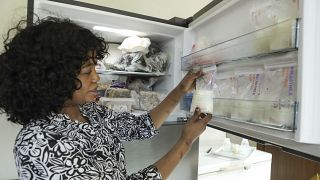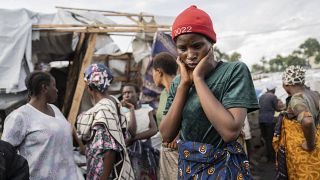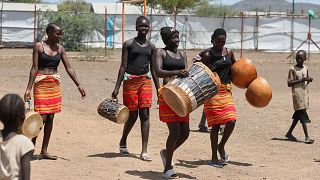Kenya
Respiratory diseases affect the health of millions of people in Kenya, with the main cause the burning of biomass like firewood. But without affordable alternatives, most Kenyans continue to rely on traditional cooking fuels.
Jane Muthoni is collecting firewood to light a fire in her kitchen made of iron sheets.
Soon the roof, walls and wooden pillars are covered in soot. As she blows on the flame for tea, the 65-year-old is engulfed in smoke.
"I have been using firewood all my life and wake up every morning to fetch it. However, the smoke from the firewood makes me cough over long periods and causes difficulty in breathing. LPG gas is quite expensive, and I cannot afford it," she says.
Respiratory diseases have been the most prevalent diseases in Kenya for the past six years, according to government authorities, with 19.6 million reported cases in the most recent study released this year.
Indoor pollution
Biomass such as firewood is the largest contributor to those diseases, says Evans Amukoye, a scientist at the Kenya Medical Research Institute's respiratory diseases research centre.
"It is not only carbon monoxide but one of the biggest problems is particulate matters. The particulate matters are the ones we usually call PM 2.5 and this is associated with pneumonia, it is the one associated with asthma and so on. And it is usually brought around by fuel for cooking. There is even one study that is going on in KEMRI (Kenya Medical Research Institute) called "Clean Air" which we are trying to use clean air like LPG. LPG is just the gas that we use and is slightly safer compared to paraffin or compared to things like charcoal. Electricity would be the cleanest but is a bit expensive."
Data from Kenya’s health ministry shows that chronic obstructive pulmonary disease is responsible for 1.7% of deaths in the country.
Reliance on biomass fuels
People in low-income areas are diagnosed with respiratory diseases later in life compared to middle-class people in urban areas with better awareness and access to health care, according to Amukoye.
The Economic Survey of 2024 said Kenyan households used 93.8% of all energy mainly in the form of firewood.
Families in informal neighbourhoods and rural areas are the most affected, with most people relying on firewood or fossil fuels for cooking.
The 2022 Demographic and Health Survey showed a high dependence on traditional fuels for cooking in Kenya, with households depending on biomass like firewood increasing from 4.7 million to 6.7 million between 2020 and 2022.
Overall, 9.1 million households rely on traditional cooking fuels, the survey said.
Cleaner alternatives
Mercy Letting, a businesswoman in Nairobi was using charcoal to make meals for customers in her restaurant. With time, it affected her health.
Letting bought an induction burner which she says is faster in cooking and more efficient as she spends only 50 Kenyan shillings ($0.38) per day on electricity, and the charcoal she buys for her “eco-friendly” stove lasts her up to two months.
She has seen an improvement in both her health and her bank balance she says :
"While using these stoves, I can use a sack of charcoal for two months, unlike before. Thus, I am able to save 4500 shillings (34 US Dollars) in extra money. Moreover, in terms of my health, I don’t go to the hospital as often as before and I am able to be at work throughout. This translates to more profits."
A global issue
Globally, 2.3 billion people rely on open fires or fossil fuels like wood, charcoal, and kerosene for cooking.
The World Health Organisation attributed an estimated 3.2 million deaths in 2020 to household pollution, including over 237,000 children under five. In Sub-Saharan Africa, more than 900 million people depend on these fuels, and the number is rising.
Across Africa, women and children make up 60% of early deaths related to indoor air pollution, according to the International Energy Agency (IEA). An annual investment of $8 billion is needed in clean cooking stoves, equipment, and infrastructure to address this crisis.
Accelerating energy efficiency
The IEA held its 9th annual conference in Nairobi in May, its first time holding the event on the continent.
This year the IEA, with representatives from nearly 70 countries from around the world, focused on accelerating energy efficiency progress.
Kenya’s Cabinet Secretary of Energy and Petroleum, Davis Chirchir, a co-host at the conference, said that Kenya is working towards "the doubling [energy efficiency] goal as part of its efforts to achieve universal access to electricity by 2030".
The country has seen electricity access expand from just 20% in 2013 to nearly 85% in 2019, with northern Kenya the region with the lowest access rates.













00:28
Nairobi hawker shot at close range by police declared brain dead
11:15
AI drones lead breakthrough against malaria in Africa [Business Africa]
01:29
Experts warn of danger of exercising in extreme heat and humidity
01:07
Kenya prepares for first anniversary of Finance Bill protests
01:52
UN's crucial humanitarian aid work faces a clouded future amid cuts in funds
02:00
Refugees in Kenyan camp face hunger after USAID funding freeze